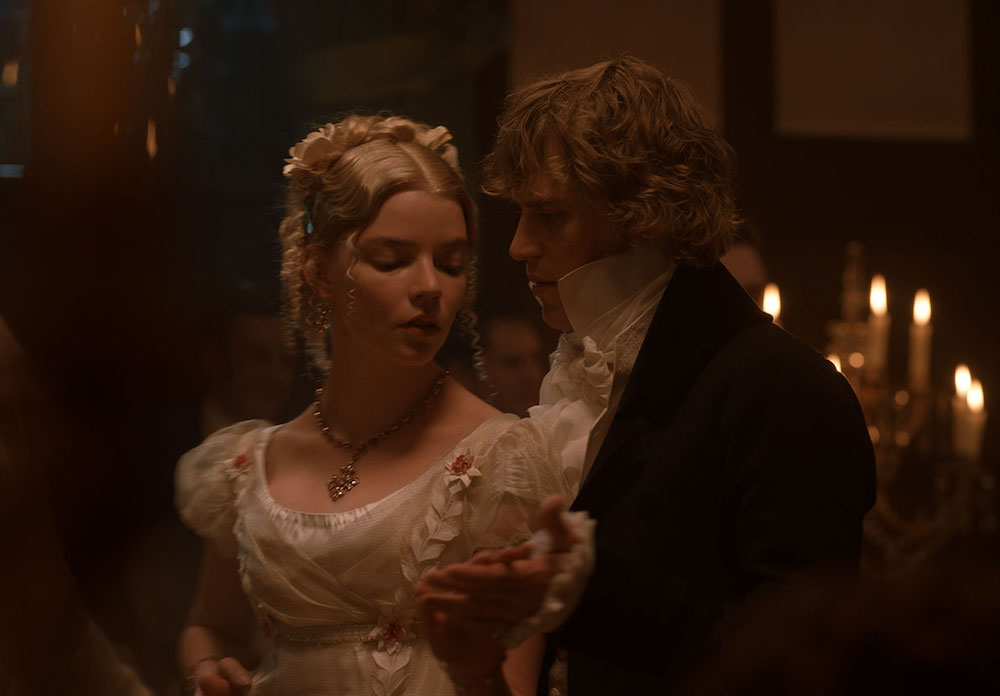The coronavirus has thrown a wrench into Aries season, but plans for my March birthday remained unchanged. I watched Autumn de Wilde’s new adaptation of Jane Austen’s Emma entirely alone. I am a harsh critic when it comes to film versions of Austen and consider myself a purist—a champion of the Pride and Prejudice BBC miniseries, which culminates in Colin Firth as Mr. Darcy diving into a pond at Pemberley, scantily clad by Regency standards. As far as Emma is concerned, I am a tried-and-true disciple of Clueless and find Cher Horowitz hard to match, even by a silky-skinned, pre-Goop Gwyneth Paltrow in the 1996 version. Anya Taylor-Joy, however, is the perfect Emma, exuding a quiet, even intimidating confidence; her tight blonde curls and perky ruffs are a flawless manifestation of her character. Emma’s world, too, is an appetizing spectacle in de Wilde’s film, the walls of the Woodhouse estate painted in decadent pinks and greens. To match, every inch of the banquet tables is covered in absurd towers of cakes, puddings, and tarts. Against my recent sluggish tendencies, Emma has inspired me to action. I will surely emerge from this quarantine an accomplished lady with a penchant for matchmaking, clad in only hand-stitched ruffs, and always poised for a contra dance. —Elinor Hitt
What’s more exciting about having a mutual crush than the unspoken lexicon of codes and signals that you both somehow know to employ? Like the lingering glances when you pass each other in the hallway. It’s a touchstone of high school life, and so it is for Olivia, the eponymous protagonist of Dorothy Strachey’s 1949 novel about a teenager who develops a crush on the headmistress of her new boarding school in fifties France. Coded language is essential to LGBTQ literature of a certain era, though I’d argue that Olivia has a relatively heavy hand (possibly because Strachey wasn’t certain it would ever be published). Olivia’s vivid desire is interwoven with the enlightenment of her education (the moment she falls in love is when Mlle Julie reads aloud from Jean Racine’s Andromaque). The complications of the boarding school’s all-female world, its relationships and jealousy, soon unfurl into tentacles that threaten to strangle all involved. But through the melodrama cuts the fresh frankness of Olivia’s all-consuming ardor, and in her Strachey captures perfectly the urgency, excitement, and fire of a first adult crush. —Lauren Kane
This week, as news of stubborn college students flooding Florida and Gulf Coast beaches made the national news, I’ve been thinking a lot about Harmony Korine’s 2012 film Spring Breakers. It’s a trip, on many levels—the classic road trip story of four coeds (including, notably, Selena Gomez) escaping the rigid confines of their Christian college for a memorable week on the beach. Also trippy: the bacchanalian scenes, shot with glee (fair warning: there is a lot of booty) and a tremendous eye for color (Korine seems to have mainlined the pastels and neons of Miami Beach). Trip number three: James Franco playing a high-ish roller named Alien—it’s a bombastic role, played with relish, and a lot of fun to watch. Of course things go sideways, operatically so. Come for the vicariousness; stay for the cautionary tale. I don’t wish ill will on any undergrad, and it’s unfortunate that spring break (along with book tours, major league baseball, and a million other things we were looking forward to) got canceled, but after watching Spring Breakers again, I am more confident than ever that sometimes it’s best to stay off the beach. —Emily Nemens
Last year, the nominees for the Goldsmiths Prize in experimental writing included the intriguingly named Good Day?, by Vesna Main, a Croatian writer living in London. I hadn’t heard of her, but descriptions of the plot intrigued me, and so I hastily started to search for more information about Main’s work. Described by her publisher as “variations and fugue on the theme of obsession,” her 2018 short story collection Temptation: A User’s Guide is a witty compendium of recalibrations of Modernism, from “Mrs. Dalloway”—a sly contemporary take on Virginia Woolf’s classic—to “Love and Doubles,” whose fascinating thesis concerns the plagiarism of desire. Along the way, Main explores violence, obsession, and love in a series of stories that are as clever as they are formally interesting. —Rhian Sasseen
The adrenaline started way before the lights came up and has never faded. This past spring, my gentleman and I realized we had one last chance to see our genius friend Taylor Reynolds direct a play in our own neighborhood. We had ten minutes. We made it. Were there seats? We were on standby. Then we were sitting front row, stage left, and I have never been more scared nor laughed harder in a theater—screen or stage. We were watching Plano, by Will Arbery, who won a Whiting Award on Wednesday night. I wish I had been in a room of people to shout at the top of my lungs—I know that if New York continues, I’ll have another chance. Plano is about three sisters who are in a space-time vortex in Texas—or is it the vortex of family and habit? The dialogue spins ahead by a clever tick in which Arbery has the characters explain, “It’s later,” without missing a beat. It’s a tidy joke on storytelling, on stagecraft, on metafiction, and on the audience: “It’s later. I’m pregnant.” There are fucking belters, and there is a man without a face. The sister who has a string of ailments explains the whole span of contemporary health anxiety: “NO, I’m fine. It’s celiac. It’s endometriosis. It’s fibromyalgia. It’s FULL UTERINE FAILURE.” There is a husband who splits into two—one of whom (spoiler) is smothered with Karl Ove Knausgaard’s My Struggle. There is no description of the play I can give to credit its lift. Any number of these devices could have been stickily cerebral, but instead, Arbery’s feeling (the man has seven sisters) and Reynolds’s good judgment brought me to tears of laughter, joined fully by the women behind me. So delighted were we all that we stood talking after the show—together in our admiration. Someday again there will be theaters, big and small, filled with people. Here’s hoping that when the lights come up again, they’re on Will Arbery. —Julia Berick
from The Paris Review https://ift.tt/2QOuGFE



Comments
Post a Comment